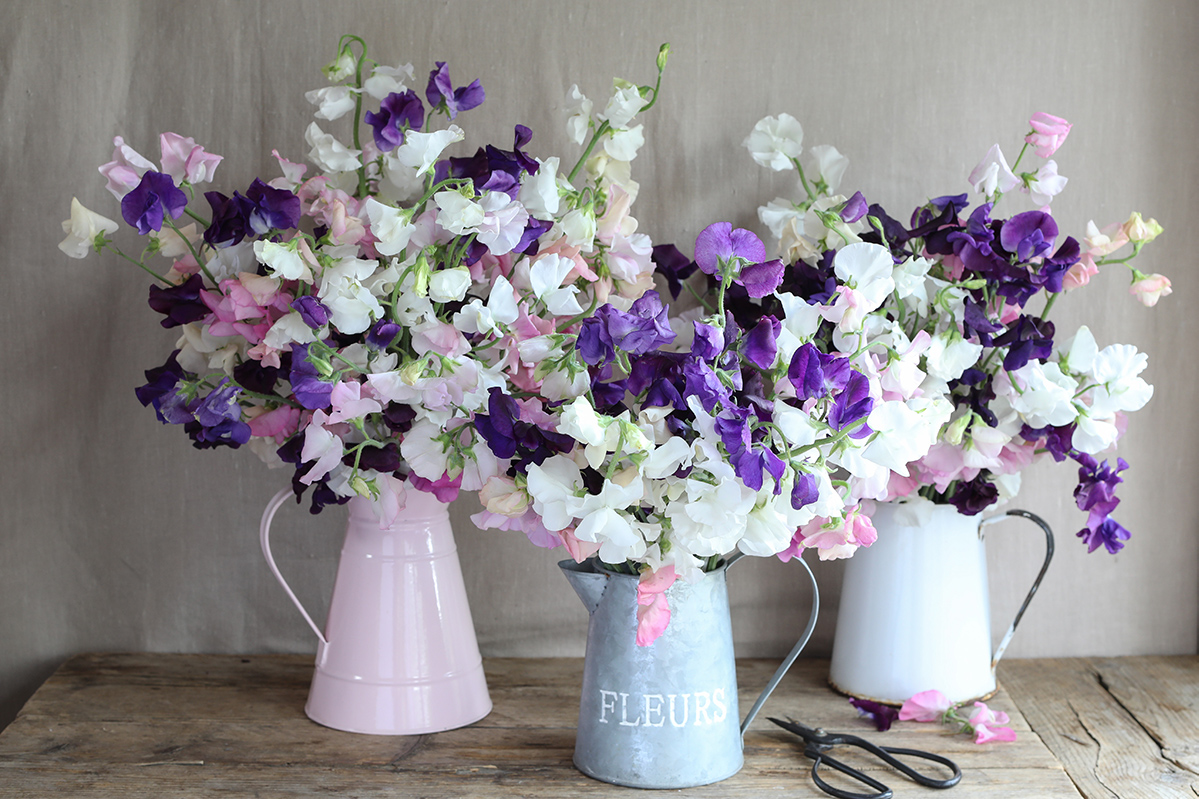We use cookies to make your experience better. Read more
Growing Sweet Peas – Frequently Asked Questions

For our founder Rosebie Morton, it’s the dream of sweet peas that helps to keep her spirits high through the dark months of winter. Rosebie grew up in a military family that was constantly moving from place to place, but wherever they ended up, her mother Elspeth would create an English garden – where sweet peas took pride of place. “As soon as the first shoots appear and the tendrils beckon, one’s nose starts twitching for that first whiff of exquisite fragrance,” she says.
Over the decades since she founded The Real Flower Company, Rosebie has refined her knowledge of growing this delicate, fragrant flower to a fine art, and today we tend around a million sweet peas a year on our farm just off the South Coast. We asked our Instagram and Facebook followers for their questions on how to grow this quintessential English bloom – and below Rosebie brings her expertise to answer your questions.
Do you have any tips for producing flowers with long stems suitable for using as cut flowers?
Growing sweet peas with long stems that look gorgeous in our bouquets is one of the areas we have focused on at The Real Flower Company. The choice of variety can to a certain extent dictate the length of stem – for example, the Spencer varieties are naturally longer stemmed. But the other major factor in achieving long stems is to take off the tendrils to avoid them tangling and giving you bendy, twisted short stems.
What should you do if your sweet peas grow tall but don't flower?
If your plants aren’t flowering, it could be that they are not getting enough light (they need a minimum of 8 to 10 hours a day, but preferably nearer to 16 hours). If the area where they are planted is too shady, you would do well to move them to somewhere sunny – but make sure you choose a coolish day and water them in well to help them settle. Lack of flowers can also sometimes be a result of too much nitrogen fertiliser, which produces tall, leafy plants but no flowers. To overcome this, feed the sweet peas with either a high phosphorus feed or some bone meal.
I planted my sweet peas out in early April and they just don't seem to be growing – have you any tips?
When your sweet peas are between 4 and 8 inches in height and have approximately four sets of double leaves, just take the growing tip above the top set of the double leaves between your thumb and index finger and use your nail as a blade to remove the growing tip. This will encourage the hormones to produce stronger, bushier growth and more flowers.
I’m growing sweet peas on my bedroom windowsill but I'm worried they’ll get too soft to plant out and that I’m keeping them indoors too long. It’s the first time I've tried to grow them from seed!
You need to pinch out the tips so they bush out a bit and don’t get too leggy. Then when you see new growth forming, transplant them to their final growing position in full sun. Keep them well watered but not waterlogged and feed them fortnightly with a high phosphorus feed after the first flowers are formed.

Is it better to grow sweet peas from seed or to buy plug plants? And if you do buy plug plants, should you separate out the plants within a single plug?
Growing from seed gives you more choice of variety, but if you’ve missed the opportunity, plugs can be a great alternative. Don’t separate out the plants – just get them into the ground in a well-prepared site and let them get established.
What should you look for when buying plug plants?
Check that the plants look healthy and are not yellowing. Avoid very leggy and spindly plants or ones that look root bound.
The fabulous fragrance of sweet peas and their delicate form make them the ideal flower to bring the promise of summer into your home. We have a number of spectacular bouquets that feature sweet peas grown on our own English flower farm then hand-tied into glorious arrangements by our expert florists, you can also buy freshly cut English sweet peas in bunches of 25, 50,75 or 100 stems. You can shop our sweet pea collection here.


